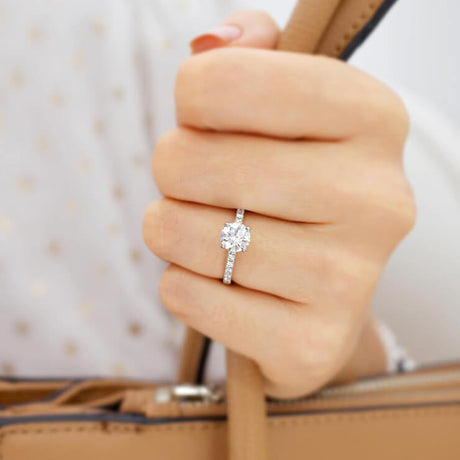The Victorian Era, spanning from 1837 to 1901 during the reign of Queen Victoria, was a time of significant change and development in various aspects of society, including fashion. This period is renowned for its elaborate clothing, intricate styles, and the introduction of various accessories, among which the engagement ring held a special place. The engagement ring became a symbol of love and commitment during this time, reflecting the era’s values and the evolving perceptions of romance. This article delves into the fashion and trends of the Victorian Era, showcasing how clothing, jewelry, and societal norms shaped the styles of the time.

Fashion in the Victorian Era
Victorian fashion was characterized by its opulence and attention to detail. Women’s clothing evolved dramatically, moving from the simpler styles of the Regency period to the more structured silhouettes of the Victorian era. The introduction of the corset was pivotal, as it created the hourglass figure that became the idealized shape of the time. Skirts grew wider, supported by crinolines and later bustles, allowing for a dramatic and feminine appearance. Fabrics such as silk, velvet, and lace were commonly used, often adorned with intricate embroidery and embellishments.
For men, fashion during the Victorian Era was equally significant. Tailcoats, waistcoats, and trousers became the standard attire. The well-dressed Victorian gentleman was expected to embody sophistication and style, with attention given to details like hats, gloves, and pocket watches. The period also saw the rise of the three-piece suit, which became a staple of men’s fashion and remains popular today.
Jewelry Trends
Jewelry in the Victorian Era was more than just an accessory; it was a reflection of status, wealth, and personal expression. The engagement ring gained popularity during this time, transitioning from simple gold bands to more ornate designs featuring diamonds and colored gemstones. Victorians believed in the significance of gemstones, and each stone was thought to carry its own meaning. For instance, diamonds symbolize purity and strength, making them a popular choice for engagement rings.
The design of jewelry was influenced by various factors, including the Romantic Movement and the fascination with nature. Floral motifs, hearts, and even mourning jewelry became popular. Mourning jewelry, made from materials like jet or black enamel, was worn to commemorate the deceased and often featured hair or portraits of the departed, showcasing the era’s complex relationship with grief.
Fashion Influences and Innovations
The Victorian Era also witnessed the emergence of fashion magazines and the concept of haute couture. Designers like Charles Frederick Worth pioneered the idea of presenting seasonal collections, influencing the way people viewed fashion. This democratization of fashion allowed more individuals to access the latest trends, with fashion shows becoming popular events.
Technological advancements during the Victorian period, such as the sewing machine and synthetic dyes, revolutionized clothing production. Mass production made clothing more accessible, allowing for a wider variety of styles and fabrics. Women began to wear ready-to-wear clothing, which paved the way for the modern fashion industry we know today.
Societal Influences on Fashion
Fashion during the Victorian Era was also deeply intertwined with societal norms and values. The period emphasized modesty and propriety, particularly for women. Clothing often covered the body from neck to ankle, reflecting the ideals of femininity and virtue. However, as the era progressed, women’s rights movements began to influence fashion, leading to more practical and comfortable designs. The introduction of the “New Woman” concept saw a shift towards more active lifestyles, prompting changes in women’s clothing to accommodate their growing independence.
Conclusion
The Victorian Era was a time of rich cultural and fashion evolution. From the opulent clothing to the meaningful jewelry, including the cherished engagement ring, this period left an indelible mark on fashion history. The intricate designs and societal influences of the time continue to inspire contemporary fashion, reminding us of the elegance and complexity of the Victorian Era. Whether through the extravagant gowns of its women or the sophisticated attire of its men, the legacy of Victorian fashion remains a fascinating subject of study and admiration. As we explore these trends, it’s essential to appreciate how they shaped not only the clothing of the time but also the social fabric of an era that valued beauty, commitment, and innovation.